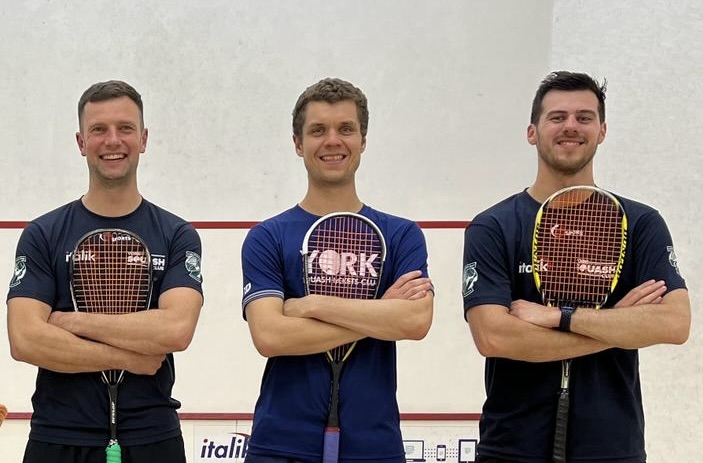
Yorkshire trio’s lockdown project is in big demand across the world
By MIKE DALE (Squash Mad Correspondent)
Squash Mad writer Mike Dale speaks to Jamie Abbott, co-founder of squash data business Cross Court Analytics. The service is earning praise from top coaches and PSA Tour players such as Amanda Sobhy and Declan James for the insights it provides into its clients’ and opponents’ performances. We found out more…
LIKE so many ideas, it began during lockdown. Jamie Abbott and fellow York Squash Club players James Brunton and Michael Abbotson suddenly couldn’t whack a little black ball around four times a week and were keen to channel their energy and squash passion into something else.
Abbott was doing a part-time Masters in Linguistics which relied heavily on data collection and analysis and had keenly followed the data revolution in football and cricket (in terms of performance analysis for coaches/players, consumption by fans through the media and for the betting industry).
“I searched for what data analysis was out there in squash and was intrigued to learn that there was very little in the public domain. As we’ve learned over the last two and a half years, there wasn’t much going on in the private domain either,” Abbott says.
Abbott began manually logging data from matches on SquashTV, including shot locations, errors, winners, volley metrics, rally lengths and ‘heat maps’ (graphic visualisations of the most frequented areas of the court by both players during a match).
He then brilliantly contextualised this data into easily digestible blogs, not just regurgitating match statistics and trends, but demonstrating to readers why certain matches or performances were remarkable or unusual, and why certain tactics had been successful (this analysis of Paul Coll’s victory over Ali Farag in this year’s British Open final is a great example).
The players started to take notice. First, Sussex-based Camron Malik asked Crosscourt Analytics to analyse the performances of his children (Curtis, Perry and Torrie are pros, while Bailey and Heston are top juniors), then Camille Serme got in touch, followed by the French squash federation, Amanda Sobhy, England Squash, Scottish Squash and Squash TV.
They each wanted to access different aspects of the data for a variety of purposes – insight into where players make most errors, the shots or combinations that win them most rallies or ‘deep dives’ into their own strengths and weaknesses or those of particular opponents (as was the case with Serme and Sobhy).
Abbott explains: “Collecting and analysing the data is one thing but communicating that in a meaningful way to players is the biggest battle in many respects.
“We did a project with England Squash where (National Assistant Coach) Nick Matthew used our data with Declan James to break down his errors by shot location and shot type.
“It helped crystallise what Nick and Declan had thought was happening, but having the data in front of them was particularly beneficial. There’s no escaping the hard facts!”
England head coach David Campion commented: “Working with Cross Court Analytics has given us the tools to drill down into how our players win or lose their rallies. The range of data they collect is phenomenal. Having all the stats to augment what we see (or often don’t always see!) is extremely valuable to a player’s development.”
French national coach Renan Lavigne said: “We’re constantly seeking an edge for our top players. Cross Court Analytics’ numbers allow us to prepare for upcoming matches with greater precision than ever before.”
The analytics team can only start to pick out trends and tactical interventions once baseline data is in place. “Once you’ve built up a data profile of past matches you can start providing more insight,” explains Abbott.
“For example, if you know the average amount of times players use height on the front wall against Ali Farag is 5%, then finding out that Paul Coll lifts the ball 22% of the time against Farag when he beats him is pretty useful.”
Abbott writes the popular blogs and liaises with clients, Brunton has developed the analysis software and Abbotson has helped turn the project from a blog into a business.
They pay six squash-playing students from York University to do data entry and Cross Court Analytics sponsors the university squash team in return.
Abbott, Brunton and Abbotson all have their own jobs while running Cross Court Analytics as a sideline. “It’s still a weekend and evening hobby, but we’d love to work in-depth with more major federations and Squash TV,” says 28-year-old Abbott.
“I really think our numbers can shed light on the way matches are played at pro level and bring a new angle to people’s viewing. Jonny Williams (Squash TV’s Aussie commentator) has really championed us from the start and has fought our corner.
“We are under no illusions, squash is a small sport and that’s partly why there isn’t competition for us in the sport yet.
“We are first and foremost squash players and fans, not sports business people. That is why we keep on churning out these numbers when it’s not yet hugely lucrative for us.
“However, it’s a wonderful thing to have spent your weekend recording data on a squash match and then have someone on social media say that is has made them think differently about the game.”
Pictures courtesy of Cross Court Analytics















 Phone: (800) 737. 6040
Phone: (800) 737. 6040 Fax: (800) 825 5558
Fax: (800) 825 5558 Website:
Website:  Email:
Email: 






